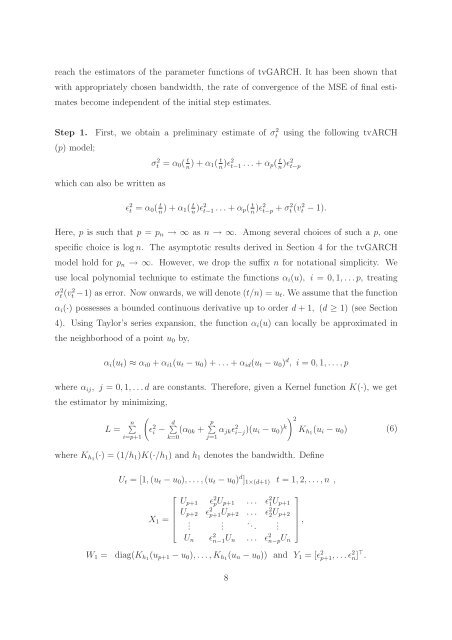Non-parametric estimation of a time varying GARCH model
Non-parametric estimation of a time varying GARCH model
Non-parametric estimation of a time varying GARCH model
You also want an ePaper? Increase the reach of your titles
YUMPU automatically turns print PDFs into web optimized ePapers that Google loves.
each the estimators <strong>of</strong> the parameter functions <strong>of</strong> tv<strong>GARCH</strong>. It has been shown that<br />
with appropriately chosen bandwidth, the rate <strong>of</strong> convergence <strong>of</strong> the MSE <strong>of</strong> final esti-<br />
mates become independent <strong>of</strong> the initial step estimates.<br />
Step 1. First, we obtain a preliminary estimate <strong>of</strong> σ 2 t using the following tvARCH<br />
(p) <strong>model</strong>;<br />
which can also be written as<br />
σ2 t = α0( t t ) + α1( n n )ǫ2t−1 ... + αp( t<br />
n )ǫ2t−p ǫ2 t = α0( t t ) + α1( n n )ǫ2t−1 ... + αp( t<br />
n )ǫ2t−p + σ2 t (v2 t − 1).<br />
Here, p is such that p = pn → ∞ as n → ∞. Among several choices <strong>of</strong> such a p, one<br />
specific choice is log n. The asymptotic results derived in Section 4 for the tv<strong>GARCH</strong><br />
<strong>model</strong> hold for pn → ∞. However, we drop the suffix n for notational simplicity. We<br />
use local polynomial technique to estimate the functions αi(u), i = 0, 1,...p, treating<br />
σ 2 t (v 2 t −1) as error. Now onwards, we will denote (t/n) = ut. We assume that the function<br />
αi(·) possesses a bounded continuous derivative up to order d + 1, (d ≥ 1) (see Section<br />
4). Using Taylor’s series expansion, the function αi(u) can locally be approximated in<br />
the neighborhood <strong>of</strong> a point u0 by,<br />
αi(ut) ≈ αi0 + αi1(ut − u0) + ... + αid(ut − u0) d , i = 0, 1,...,p<br />
where αij, j = 0, 1,...d are constants. Therefore, given a Kernel function K(·), we get<br />
the estimator by minimizing,<br />
L = n�<br />
�<br />
ǫ<br />
i=p+1<br />
2 i − d�<br />
(α0k +<br />
k=0<br />
p �<br />
αjkǫ<br />
j=1<br />
2 i−j)(ui − u0) k<br />
�2 where Kh1(·) = (1/h1)K(·/h1) and h1 denotes the bandwidth. Define<br />
Ut = [1, (ut − u0),...,(ut − u0) d ]1×(d+1) t = 1, 2,...,n ,<br />
⎡<br />
⎢<br />
X1 = ⎢<br />
⎣<br />
Up+1 ǫ 2 pUp+1 ... ǫ 2 1Up+1<br />
Up+2 ǫ 2 p+1Up+2 ... ǫ 2 2Up+2<br />
.<br />
.<br />
...<br />
Un ǫ 2 n−1Un ... ǫ 2 n−pUn<br />
.<br />
⎤<br />
Kh1(ui − u0) (6)<br />
W1 = diag(Kh1(up+1 − u0),...,Kh1(un − u0)) and Y1 = [ǫ 2 p+1,...ǫ 2 n] ⊤ .<br />
8<br />
⎥<br />
⎦ ,



